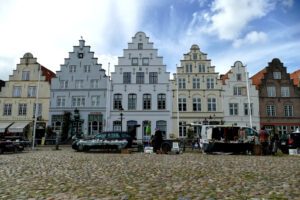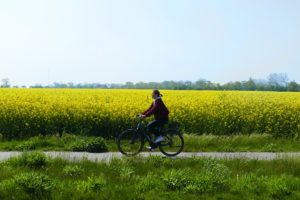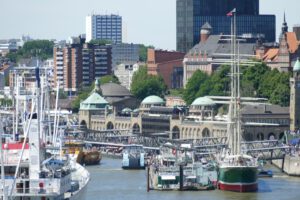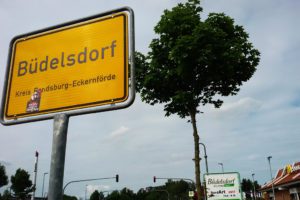Whether you prefer beer or wine is, of course, a matter of taste. However, for some people, it is also a philosophical and social question. In fact, it was none other than Scottish novelist Robert Louis Stevenson who equated wine to poetry in a bottle. And as a world-famous writer, he certainly knew what he was talking about. No one said that about beer.
But no matter what your personal opinion on the cultural difference between beer and wine is, in one respect, you can only give preference to the latter: namely, when it comes to the beauty of the growing regions. In this regard, the grapevines beat the hop bushes by a mile! Proof of this was my recent hike along the Saxon Wine Trail. With its idyllic vineyards, enchanting castles, and magnificent villas, a day trip from Dresden into the Elbe Wine Region will definitely be one of the most heart-, soul- and stomach-filling trips you will have enjoyed in a long time.

Since the trail is lined not only by some amazing landmarks but also by countless eateries and wine bars, all you need are your hiking boots, a sun hat, and a little drinking water. Everything else is readily waiting for you alongside this truly mesmerizing path!
The Saxon Elbe Wine Region
During my visit to Dresden, I made time to get a taste of the Saxon Elbe wine region. And this impression will be lasting.
With good soils, a favorable climate, and, above all, centuries of experience, Saxony offers perfect conditions for viticulture. Around 500 hectares of vineyards make Saxony a relatively small wine-growing region. Hence, the focus here is more on quality than on large quantities.

The Saxony wine-growing region is the northeasternmost of the thirteen wine-growing regions in Germany. Winegrowing here has several special features and unique selling points. It is particularly noteworthy that, with around 1,500 small winegrowers, only 45% are full-time winemakers. The others pursue their passion as a side hustle or even as a hobby. However, this in no way diminishes the highest quality of the product.

The Elbe Valley’s favorable climate makes it possible to produce excellent wines in this area, located at over 51 degrees north latitude. Long periods of sunshine in summer and autumn pamper the grapes.
The Saxon Wine Hiking Trail
The small but exquisite wine-growing region lies in the Elbe Valley, just outside the city of Dresden. The so-called Saxon Wine Trail begins in Pirna, which is about half an hour south of the city. It connects the gems of Dresden’s surroundings along the Elbe River, passing Radebeul, Meissen, and other treasures, all the way to Seusslitz.
The trail guides you to the most beautiful vineyards, majestic viewpoints, and impressive wine cellars. You’ll discover striking testaments to the Elbe Valley’s over 850 years of history of winemaking, as well as some state-of-the-art wineries. Even off the Saxon Wine Trail, just a small detour away, you can discover all sorts of attractions.

Obviously, along the way, hikers and cyclists have numerous opportunities to sample rare wines from over 60 grape varieties. Above all, don’t miss out on the Gold Riesling, which is only grown in significant quantities here on the Elbe River!
If you’re more of a theorist than a drinker, you should make time in Radebeul for the Saxon Winegrowing Museum in Hoflößnitz. You’ll also find Europe’s first winery experience at Wackerbarth Castle. The Wine Experience World of the Saxon Winegrowers’ Cooperative in Meissen also offers fascinating insights into the history and present of winemaking. Meissen, by the way, is one of the places you should by no means miss out on. I’ll publish a comprehensive guide on August 16.
The Path is the Goal
You can choose from various modes of transport to discover the idyllic vineyards. On a leisurely hike through the Elbe Valley, a well-marked trail leads you through the magnificent landscape. It is almost 90 kilometers long and is divided into six legs. They average 15 to 18 kilometers, which equals five to six hours of walking. Of course, you can also plan your individual sections according to your personal condition and preferences. The trail can be hiked in both directions, and you can start anywhere. This makes it ideal even for one-day tours.

At the end of the trail, you’ll have a hard time choosing between the numerous historic wine taverns in Seusslitz. Also, make sure to leave some room in your backpack or saddlebags for at least one souvenir bottle of wine, which you can then enjoy later at home while reminiscing about your wonderful trip.
My Tip
During the summer months, you can sail comfortably and in style from Dresden to Meissen and beyond with the Sächsischen Dampfschifffahrt, hence, the Saxon Steamship Company. The ship usually departs daily from May to October at 9:45 a.m. from Dresden’s jetty Terrassenufer. At a leisurely pace, it then travels upstream through the picturesque Elbe Valley and along the Saxon Wine Route. The return trip is in the afternoon.

The round trip costs around 30 €uros. Due to limited seating, advance reservations are recommended. Their informative website is also available in English.
On Tour With Marcel Beier
Marcel Beier is a connoisseur. He trained as a restaurant specialist in a 4-star hotel and has been a passionate host ever since. And a perfect host he is, not only when it comes to culinary delights. He also leads his hikes through the Saxon vineyards with great dedication and attention to detail.
“I’m originally from the Ore Mountains. But after seeing the Saxon wine region, I fell in love. I wanted to live here! My mother wasn’t keen on the idea at first, but then she came along.”
Well, they say that behind every successful man there is a strong woman, and that’s certainly true for the Beiers. While Marcel entertains and informs guests with dedication and eloquence in the foreground, his mother, Heike, works in the background and makes sure that everything runs smoothly.

As our group arrives at the meeting point, she has already set up a folding table on the banks of the Elbe and is pouring sparkling wine into glasses. Seems like we’ll be hiking in style. Only sparkling wines from the Champagne region are allowed to be called Champagne. Yet, this bubbly was produced using the champagne method, and it tastes’n’tingles just as seductively.
Marcel welcomes the participants of today’s hike. Funnily enough, it’s a family of six from the surrounding region who want to explore their figurative backyard, plus Kathrin and me. Kathrin is in charge of the Open Winery Weekend. I’ll get to that below.

So, while we are enjoying our drink, our small group is given the first facts and figures in an entertaining way. This welcome drink is the first glass of today’s hike, however, it doesn’t even count toward the five wines tasted during the tour. So let the fun begin.
A Walk in the Park – Literally
Initially, I was a little worried that I’d have to climb steep slopes and endless stairs for hours on the tour.

This worry quickly vanished. We stroll leisurely through the village of Seusslitz, learning everything that makes this wine region so special, down to the last detail.
Upon arrival at Seusslitz Castle, the first wine is served, accompanied by a flood of information. It’s a Gold Riesling, a grape variety grown only in this region in significant quantities. Marcel calls it a breakfast wine. I don’t know about that, but it’s definitely fruity and light.
While we enjoy our second, liquid breakfast, Marcel tells us about the castle complex.
An Empty Place
The Baroque Seusslitz Palace is picturesquely nestled in the charming vineyard scenery and surrounded by a terraced French-style palace park. Originally a monastery, the property was secularized during the Reformation. In the 18th century, the Saxon Prime Minister Heinrich von Bünau had the current palace built in the Baroque style. For many years, the palace served as a summer residence and prestigious country estate, and was a popular venue for court gatherings.

Sadly, the building has been vacant for years and is increasingly falling into disrepair. Its use as a retirement home ended around 2000, after which the building was not used permanently any longer. The last change of ownership took place in 2022, and since 2023, the property has been publicly offered for sale through Sotheby’s International Realty. Just a heads-up if you’re currently looking for a castle.
House of Worship
In contrast to the palace, the adjacent church is still in use and therefore in considerably better condition. It was originally the monastery church of the Poor Clares’ Convent of St. Afra, founded in 1268 on the site of the present-day palace.

As part of the Baroque reconstruction of the monastery and the neighboring palace, it was redesigned from 1724 onwards by the famous Dresden council carpenter George Bähr. Bähr is most famous as the builder of the Frauenkirche in Dresden.

George Bähr was also responsible for the Heinrichsburg Castle, commissioned by Count Heinrich von Bünau. The simple, two-story garden house stands on a plateau opposite the castle and is accessible via four stepped terraces. Sandstone figures, allegories of the twelve months, adorn the ascent.

Unfortunately, the exhibition on the regional winemaking history can only be visited on Sundays and only during the months of April to October, between 2 p.m. and 5 p.m. But I might have good news for those who would like to learn more: There’s an audio guide for your mobile phone at the historic Heinrichsburg Staircase. At this moment, it is sadly only available in German.
An Enjoyable Break
After the church tour, we walk just around the corner, where mother Heike has already set up a buffet with local, partly homemade snacks at the Anno 1272 Wein Café. The Beiers have been running this gastronomic gem since 2018.

We fill our stomachs at the table set with ravishingly beautiful tableware from Beier’s colorful porcelain collection while Marcel pours the second wine. This red wine is so light that we can even handle a refill.

After about an hour, we’re back on the road. We stroll through the castle grounds, which are tended by volunteers, and enjoy our third glass of wine with a view of the Heinrichsburg. The mood’s in full swing, and even the climb up the long stairs to the viewpoint at the Heinrichsburg can’t change that.
Getting the Big Picture
From here, we have a million-dollar view of the castle and, behind it, the vineyards and the Luisenburg Winery. This baroque pavilion vineyard house was also designed by George Bähr as part of the harmonious ensemble of the baroque complex of Seusslitz Castle.
Originally part of a winery, it was used for viticulture. Today, the building is privately owned, so tours are not possible.

(Photo: Marcel Beier)
The climb to the Heinrichsburg was definitely worth the sweat. After an extensive photo session, there’s another steep climb through a small forest, and then we reach the vineyards on the plateau.
Marcel quenches our thirst with the fourth wine.

After a short informative break, we hike south between picturesque vineyards along the Elbe River, far below us. Here, on the bend of the Elbe, lies the spot which was awarded the title of the Most Beautiful Vineyard View by the German Wine Institute in 2020.

It’s 5 p.m., and the summer sun is slowly losing its power. Marcel pours the fifth wine, thus heralding the end of an enjoyable day, while we let our gaze wander wistfully over the Saxon Elbe region.
Plan Your Visit
I would be delighted if you’d like to join a wine hike. Marcel has been guiding guests through the region with his company, Elbtal Tours, with great expertise and dedication since 2014. His love for this landscape and the wine is evident in every word he says. He doesn’t offer a standardized program, but can tailor his so-called Adventure Days to the wishes and needs of his guests. The hikes generally take place between May and October and can be combined with, for example, a steamboat trip from Dresden. Just browse his website or shoot him an email at info@elbtal-tours.de, also in English, obviously.
Open Winery Weekend 2025
The first Dresden Elbland Open Winery Weekend took place in 2000. Back then, a modest 19 wineries participated. Since then, the event has continued to evolve. In fact, in 2025, it will be held for the 26th time, with around 50 wineries participating. Kathrin Gelfert, with whom I participated in Marcel’s hike, is in charge of this mega-event.

On the last weekend in August, wineries, taverns, and other institutions between Dresden and Seusslitz will open their doors. Because the festive winemakers can hardly wait, some are offering a warm-up program with tours and tastings already on Thursday and Friday.
You’ll sample everything from sparkling white wines to full-bodied red wines, as well as traditional winery snacks. You’ll learn more about their philosophy and grape varieties directly from the passionate winemakers. Many of the idyllic estates open their historic vaulted cellars and offer insights into modern technology and vineyard work.

(Photo: Ivanna Wübken)
Live music, artistic acts, and special events enhance the lively atmosphere.
And to ensure that no one has to be assigned as a designated driver, a shuttle system with special buses is organized. This way, you can travel comfortably and, above all, safely from winery to winery, even after your third glass of wine. A day ticket costs 10 €uros and is also valid for the Elbe ferry between Seusslitz and Niederlommatz, allowing unlimited use.
Plan Your Visit
You still have two weeks to plan a visit to this year’s Open Winery Weekend!
Especially if you happen to be in Dresden, Berlin, or even Prague at that time, I think you shouldn’t miss this fantastic opportunity. You can find all the information on their website.
And don’t forget to mark the 27th edition of this fantastic event on the last weekend of August 2026 in your calendar!
Once we’re on it: I recently visited the famous wine region around Bordeaux. If you’re interested, rush to my Perfect Guide for a Day Trip to SAINT-EMILION.
Practical Information
How to Get There And Around
The gateway to the Saxon wine region is, of course, the baroque city of Dresden. You can reach it by train from Berlin and Prague, for example, in about two to three hours. Dresden also has an international airport.
From Dresden, you can easily reach the Saxon Elbe wine region hiking or by bike.

However, you can also get to the individual towns along the Saxon Wine Trail by public transport, such as buses and regional trains. For instance, bus #407 goes from Meissen to Seusslitz every hour.
If you choose to take the train, you might want to opt for the so-called SachsenTicket. This ticket is valid for one day throughout the federal states of Saxony, Saxony-Anhalt, and Thuringia. Prices start at 33 €uros per person. Up to five people can travel with the ticket, with each additional person paying only 8 €uros. The maximum price for five passengers is therefore 65 €uros. In addition, children up to and including 5 years of age can always travel free of charge, regardless of whether they are your own children or not. They do not need to be counted when determining the number of passengers.
If the children are between 6 and 14 years old, up to three of your own or other children can travel.
This is an absolutely amazing deal, however, there is a small catch: the ticket is only valid in regional trains. Those train numbers begin with S, RE, or MET. You cannot take interregional trains such as the Intercity (IC) or Intercity-Express (ICE).
The Germany-Ticket for 58 €uro
However, if you are planning on spending more days in the region or travelling frequently by train through Germany, the so-called Deutschland Ticket is an attractive option. Following the fantastic 9 €uro-ticket, which allowed travel nationwide for a whole month from June to August 2022, there’s now the 58 €uro ticket. For good.
With the 58 €uro ticket, you can travel basically the entire country by regional trains. Those train numbers begin, for instance, with RE or MET. But keep in mind, it is not valid in interregional trains such as the Intercity IC or Intercity-Express ICE. However, you can also use regular buses, trams, subways, and suburban trains, as well as regional express trains all over Germany.

While the 58 €uro ticket is valid throughout the country, it is not linked to German citizenship. Non-residents can also purchase it. Although it is an annual subscription, it can be canceled on a monthly basis.
So if you are planning on taking regional trains in Germany as well as intercity public transportation, the Germany Ticket might be your best option.
Where to Sleep
I had the great pleasure of staying at the Jan Ulrich Winery** during my visit to the Elbe Wine Region. It’s a family-run business located directly on the Saxon Wine Trail, just before the end of the trail at Seusslitz.

The winery, located on a bend in the Elbe River, was founded in 1992 by Carola and Jan Ulrich. Their wine is grown on the vineyard above the Heinrichsburg, hence, in one of the best sites in the region. Alongside Pinot Blanc, Pinot Gris, and other varieties, the amazing rarity Gold Riesling grows here, too. The Ulrichs attach great importance to the production of natural wines and the cultivation of fungus-tolerant varieties. This reduces the need for pesticides and thus protects the environment.
Perfect Lodging
Below the vineyard, the Jan Ulrich Winery** offers accommodation in a couple of comfortable, no-frill guest rooms. Nevertheless, they are primarily a fully functioning winery with an attached eatery. This means they don’t offer a full menu including hot meals, but only local snacks such as sandwiches.
When I arrived late in the evening, a lovely staff member had prepared a so-called winemaker’s board in the fridge for me. It consisted of several types of cheese, various sausages and hams, and small delicacies like cucumbers and olives, along with fresh, crusty bread. A real treat after the four-hour train ride from Hamburg!
However, beware that they offer this only by prior arrangement.

Also, hotel guests must register for breakfast the day before. Particularly, the owner’s homemade fruit spreads are an absolutely exquisite delicacy. And so you can enjoy a Saxon breakfast at home, they also offer their spreads and dips for sale in the farm shop. Along with an extensive wine selection, obviously.

As you can see, Jan Ulrich Winery** offers guests a comprehensive feel-good package: a clean room with a view of the Elbe, many delicious local specialties, and a well-stocked gift shop. It doesn’t get any better.
What to Eat
Saxons are undoubtedly epicures and particularly enjoy simple, honest regional delicacies of the highest quality. And of course, guests also benefit from this, as they are proudly served this traditional feast with a fine glass of wine.
Between rolling vineyards, picturesque villages, and the Elbe River, the region unfolds a blend of traditional Saxon home cooking, artisanal baking, and finely tuned wine pairings.

The cuisine itself is both down-to-earth and sophisticated. Saxon Sauerbraten, slow-braised in a spicy sauce with raisins and a hint of gingerbread, is just as much a part of the menu as potato soup with marjoram and bacon. Those with a sweet tooth can opt for so-called Quarkkeulchen, fried in butter and served with apple sauce, or the legendary Dresdner Eierschecke, a three-layered masterpiece of shortcrust pastry, quark filling, and fluffy vanilla cream.
In taverns and at wine festivals, you can enjoy music and pleasant company in a picturesque setting under the vines.
Visiting Organized
The wine hike with Marcel Beier was the absolute highlight of my visit to Elbland, and I highly recommend it to everyone. But there are many other great things to do in the region. Check out these options to see if there’s something for you*:
Map
On this map, you can trace the route and find the most amazing places that I’m introducing in this post. Clicking on the slider symbol at the top left or the full-screen icon at the top right will display the whole map, including the legend.
Pinnable Pictures
If you choose to pin this post for later, please use one of these pictures:






Did You Enjoy This Post? Then You Might Also Like These:
The Island of HELIGOLAND – soft spot with rough edges
How to Visit the NordArt in 2023
FRIEDRICHSTADT – A Little Piece of Holland in Northern Germany
Baroque Splendor And River Romance: The Must-Sees of DRESDEN
NordArt 2024: Everything You Need to Know Before Your Visit
Guide to the Island of FEHMARN – Where Plan B is the Best Plan
24 hours in HAMBURG
We’ll Always Have Büdelsdorf – bye:myself at the NordArt 2017
* Disclaimer: This post was created with the generous support of Dresden Marketing GmbH. They put together an inspiring program for me and covered all my expenses. However, all opinions regarding the services are my own and were in no way influenced by my cooperation partner.
** This is an affiliate link. Hence, if you book through this page, not only do you get the best deal. I also get a small commission that helps me run this blog. Thank you so much for supporting me!








sehr cool, muss ich mir auch mal anschaun : )
Anna! Ja, es war so ein großartiger Tag, ich kann die Tour nur empfehlen! ❤️